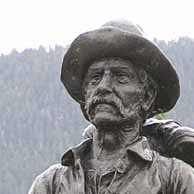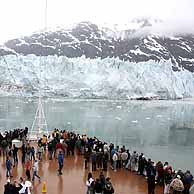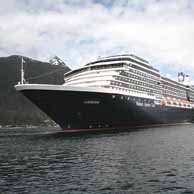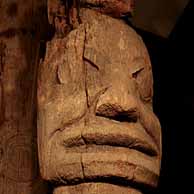Alaska was the western end of the Bering Land Bridge in prehistoric times. It is thought that the original inhabitants of North America used this avenue in their migration from Asia. Several native tribes settled in what is now known as Alaska, including the Inuit and Tlingit peoples. Legend has it that Russians landed in Alaska as early as 1648, but there is no hard evidence that this actually happened. It is known that Peter the Great was interested in exploring Alaska, but it was not until the first half of the eighteenth century that a Russian exploratory expedition consisting of two ships: the St. Peter and St, Paul set sail from Kamchatka. Vitus Bering (a Dane) and Alexei Chirikov were the leaders of the expedition. Bering's ship was wrecked and he died in 1741, but the next year his crew managed to get back to Kamchatka. The sea otter pelts that they took with them were judged to be the finest fur in the world. Sea otter hunting was very lucrative and by 1790, there were a number of small Russian settlements in the islands off of the coast of Alaska. Alexandr Baranov established the supremacy of the Russian-American Company by the beginning of the nineteenth century and had his headquarters in New Archangel (Sitka). In 1833, Britain's Hudson Bay Company established a presence. In 1867, Alaska was sold to the United States.
|
|
The United States acquired Alaska right after the end of the Civil War. In the middle of the nineteenth century, the Russian Emperor, Alexander II, needed money. He was also concerned over the difficulty that he foresaw in trying to defend the Russian territorial position in Alaska, particularly should Great Britain decide to try to capture it. In early March 1867, he instructed his Minister in Washington D.C., Eduard de Stoeki, to explore a sale to the United States. Stoeki contacted Secretary of State William Seward who expressed interest as did the sitting president, Andrew Johnson. The two sides negotiated through the remainder of the month and on March 30, 1867, finalized a treaty that would transfer sovereignty for the sum of $7.2 million. Charles Sumner, the Chairman of the Senate Committee on Foreign Affairs, shepherded the treaty through the ratification process in April 1867 and the money was appropriated in July 1868. Sovereignty was transfered in Sitka (then known as New Archangel) on October 18, 1867. Biographic note on Alexander II.
|
|










